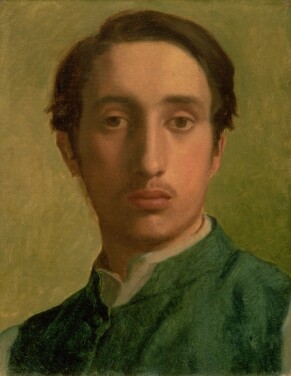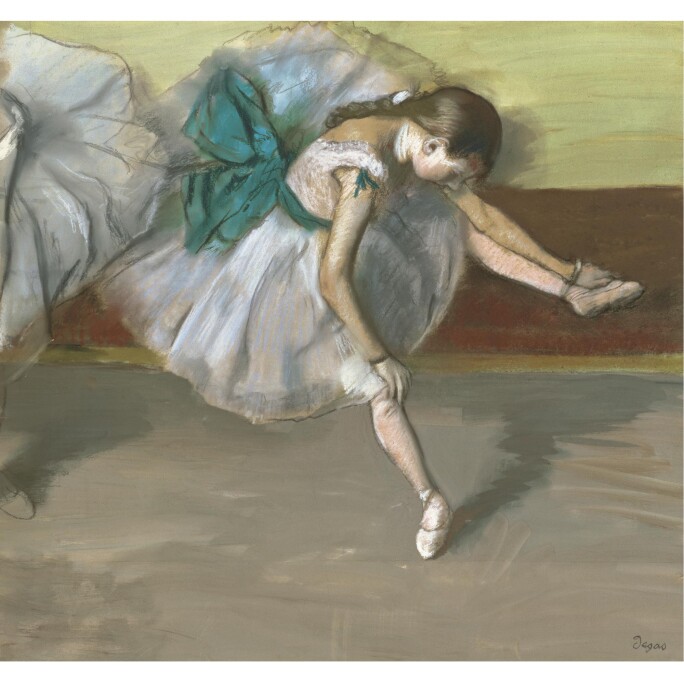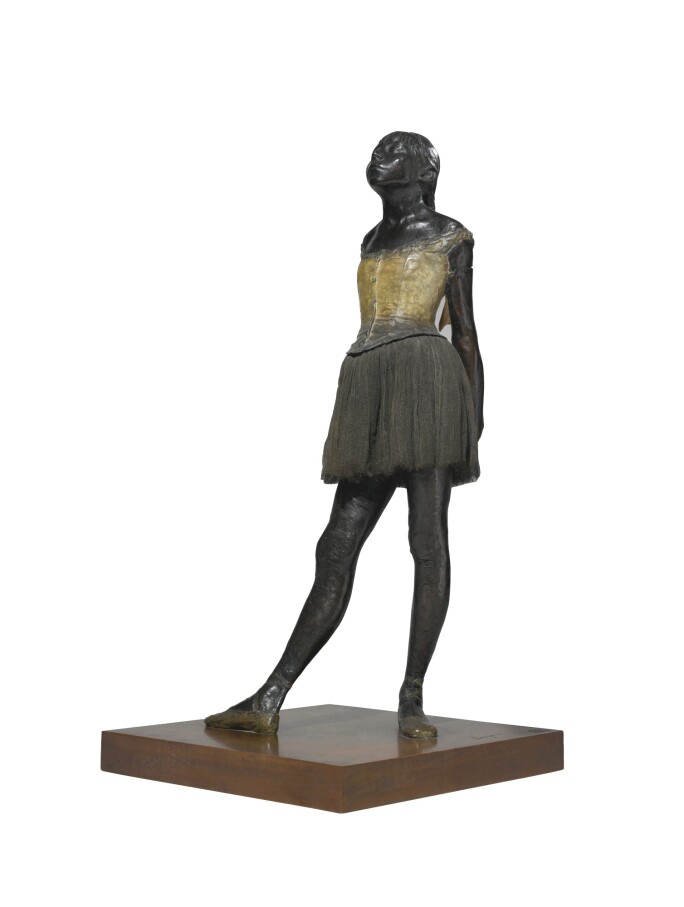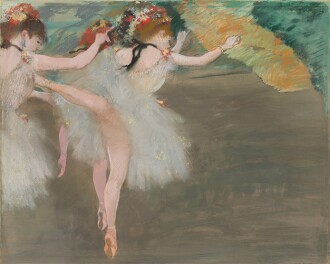1. Degas rejected the “Impressionist” label and preferred to be known as a “realist”.
Even though he took a leading role in organizing the Impressionist Exhibitions and is considered one of the movement’s founders, Degas had a contentious relationship with his contemporaries. He mocked the practice of painting en plein air, once saying: “If I were the government I would have a special brigade of gendarmes to keep an eye on artists who paint landscapes from nature. Oh, I don’t mean to kill anyone; just a little dose of bird-shot now and then as a warning.” While Degas rejected spontaneity in his work, his unconventional compositions and scenes of quotidian life place Degas, however uncomfortably, within the Impressionist tradition.
2. He initially aspired to be a history painter, but changed course in his early thirties.
Degas received his formal training at the prestigious École des Beaux-Arts, where he closely studied classical painting under Louis Lamothe. Following in the footsteps of his idol, the French Neoclassicist Jean-Auguste-Dominique Ingres, Degas produced several history paintings through the mid 1860s. In 1865, however, he turned his eye to scenes of modern life. While he would never again paint historical subjects, the influence of his academic training can be clearly discerned in his fascination with the human figure, exquisite draftsmanship and facility for line.
3. Degas was a well-heeled member of the haute bourgeoisie.
Perpetually outfitted in a frock coat and stovepipe hat, Degas was an obsessive collector of lace handkerchiefs and walking sticks.
4. Like many Impressionists, he was influenced by Japanese art and collected ukiyo-e prints.
In 1853, with the opening of trade between Japan and the west, an influx of new art into France ignited a craze for all things Japanese. Unlike many of his contemporaries, however, Degas’ fascination extended beyond staged japoneries. Instead, he abstracted from the Japanese aesthetic those elements which he found most compelling, particularly its asymmetrical compositions, inventive perspectives and delineation of space with line and color. Degas’ favored subject matter— candid moments of modern life, intimate scenes of women bathing, and of course, dancers— are also central to the ukiyo-e genre.

5. At the age of 36, Degas began experiencing visual problems, which worsened throughout his life.
Shortly after enlisting in the National Guard at the outbreak of the Franco-Prussian war, Degas developed a form of retinal disease that would lead to difficulty distinguishing colors, light sensitivity and scotoma. Because his retinopathy made it difficult for him to see in bright light, Degas preferred to work indoors, and found that he was particularly well-suited to the low light of the ballet and opera. By his forties, Degas had lost his central vision, and by the age of 57, he could no longer read. His deteriorating eyesight undoubtedly impacted his work, leading to broader strokes, bolder colors and experimentation in a wide variety of media including pastels, photography, printmaking and sculpture.

6. Financial hardship sparked his creativity.
The scion of a wealthy family, Degas suddenly found himself facing financial troubles in 1874 with the death of his father and the discovery of his brother’s significant business debts. To make ends meet, Degas sold his house and inherited art collection, and for the first time in his life became dependent on the sale of his artworks. Under mounting financial pressure, Degas embarked upon a decade of great productivity, joining forces with the budding Impressionist movement to mount a series of paradigm-shifting exhibitions.

7. His painting A Cotton Office in New Orleans (1873) was the first piece by an Impressionist to be acquired by a museum.
Degas, whose mother hailed from New Orleans, came to the city in 1872 to visit his brother René and a number of other relatives. The painting, depicting his uncle Michel Musson’s cotton brokerage business, was exhibited at the Second Impressionist Exhibition in Paris in 1876 and was sold to the Musée des Beaux-Arts de Pau in 1878.
8. Best known for his depictions of dancers, Degas produced approximately 1,500 works—over half of his oeuvre—on the subject…
Degas’ dancers explore the tension between the natural unguarded gestures of performers at rest and the stylized movements of classical ballet. From his earliest treatments of the theme, Degas showed an interest in not only the public spectacle of ballet performances, but also in the more informal situations around them: the behind-the-scenes world of the rehearsal room or the dance class, the dancers’ preparation and tension prior to a performance and the more relaxed, casual moments that followed afterwards. In the 1870s and 1880s, Degas was a fixture at the Garnier Opéra, attending both performances and rehearsals.
9. …But it was not the ballet, per se, that Degas was interested in.
In the late 1800s, the golden age of Romantic ballet had decayed into unseemly cabaret, rife with thorny sexual politics and imbalances of power. The female dancers, often from impoverished backgrounds, entered the academy as children to support their families. There, they were at the mercy of the Opéra’s unforgiving brothel culture, where wealthy male subscribers had the power to make or break their fortunes. Degas’ fascination with these backstage dynamics is apparent in L’Étoile (1879), where a partially obscured figure in a black tuxedo lurks behind the young ballerina on stage. Viewed in this context, his unsentimental portrayals of young dancers acquire yet another layer of psychological depth.

10. And while dancers may have been his favorite, they were not his only subject.
Degas’ early scenes of modern life were concerned with other favorite themes, especially horse racing and milliners and laundresses at work. Later in life, Degas produced extensive series of women bathing, which were notable for their lack of self-consciousness and candid studies of the human form, unique use of perspective, and almost sculptural solidity.
11. Degas’ brothel monotypes found an eager collector in Pablo Picasso.
Picasso found the pieces fascinating, describing them as “far and away the best thing he ever did.” He collected 12, and, inspired by Degas, created his own series of voyeuristic prints in his later years.
12. He was fascinated by physiognomy, the dubious practice of deducing personality and moral character from physical appearance.
Biological determinism was in vogue in the 19th century, particularly in the realm of criminology. Proponents believed that a “born criminal” might be distinguished by certain physical characteristics, including a protruding jawline and low forehead. Such ideas are on vivid display in Degas’ pair of 1881 pastels, Criminal Physiognomies, depicting two young gang members convicted of murdering a grocer’s boy. Degas’ interest in physiognomy went beyond criminal behavior; some historians argue that the exaggerated features of his Jewish banker subjects in Portraits at the Stock Exchange (1879) recall right-wing anti-Semitic cartoons of the time. Even his dancers receive the physiognomic treatment—he refers to his lower-class subjects as “little monkey girls”, “in the state of animals cleaning themselves.”

13. In the mid 1880s and 1890s, Degas developed a passion for photography.
With subjects ranging from dancers and nudes to portraits of friends and family (including a double portrait of Renoir and Mallarmé) and even self-portraits, Degas’ photographs evince similar aesthetic preoccupations to his work in other media. Often using only a single light source, the figures in Degas’ photographs appear to emerge from darkness and convey the startling intimacy for which his paintings and pastels are also known. Degas found photography particularly conducive to his interest in off-kilter compositions, and would continue to draw and paint from photographs throughout his career.
14. He had a long friendship and collaboration with the American Impressionist painter Mary Cassatt.
Degas and Cassatt met in 1877, when Cassatt was studying in Paris. Degas introduced her to pastels and engraving, and was instrumental in the evolution of Cassatt’s style; she, in turn, played a key role in introducing Degas to American audiences. What followed was an intense artistic friendship that lasted nearly 40 years. While the lack of surviving correspondence between the two makes it difficult to guess at the depth of their collaboration, the artwork provides a clue. In 2014, historians discovered Degas’ hand at work in Cassatt’s 1878 painting Little Girl in a Blue Armchair— infrared images taken by the National Gallery of Art in Washington, DC reveal his subtle brushstrokes.

15. The Dreyfus Affair, which divided France from 1894 to 1906, foregrounded Degas’ anti-Semitism and caused him to cut ties with all of his Jewish friends.
The scandal touched off with the wrongful treason conviction of Alfred Dreyfus, a French artillery officer of Jewish descent. The resulting political crisis divided French society between the anticlerical, pro-Republican Dreyfusards and the pro-Army, predominantly Catholic anti-Dreyfusards. Degas fell emphatically into the latter camp, along with fellow conservatives like Renoir; others, like Monet and Pissarro, were convinced of Dreyfus’ innocence. Degas was perhaps the most openly hostile member of the artistic avant-garde, described by Pissarro as a “ferocious anti-Semite”. Following the Dreyfus Affair, Degas broke with all of his Jewish associates, including his longtime friend Ludovic Halévy, and refused to use models whom he suspected of being Jewish or having Dreyfusard sympathies.
16. He created over 150 sculptures from wax, clay, and plastiline; his heirs authorized the casting of his works in bronze so that they could be sold.
Upon his death in 1917, over 150 sculptures were discovered in his studio. Most were made of impermanent materials and in various states of disrepair. Keen to sell what they could, Degas’ heirs contracted with the Hébrard foundry in Paris to cast 74 of the sculptures in bronze. While it was initially believed that Degas’ original sculptures had been sacrificed to the casting process, in 1955, 69 of the “lost” originals were rediscovered. 52 of these original sculptures are now housed in the National Gallery of Art, Washington DC.
17. The only sculpture Degas exhibited during his lifetime, Little Dancer Aged Fourteen (1878-1881), received a controversial reception, with some critics denouncing it as “ugly”.
Exhibited wearing a real dancer’s costume and a wig of human hair, the wax sculpture depicts 14-year-old Marie van Goethem, a “petit rat" who joined the Paris Ballet as an escape from poverty. Debuted at the Sixth Impressionist Exhibition in 1881, the sculpture provoked a mixture of admiration for its realism and opprobrium for the unidealized portrayal of its lower-class subject. One critic expressed revulsion at a face “marked by the hateful promise of every vice…bearing the signs of a profoundly heinous character.” Today, of course, the sculpture is recognized as an icon of modern art.
18. Degas’ Monsieur and Madame Édouard Manet (1868-69) was mutilated, presumably by Manet himself.
Degas gifted the painting, which depicts Manet reclining on the sofa as his wife plays the piano, to the couple. As the story goes, the next time he saw the picture, it had been slashed right through Mme Manet’s face. Degas was furious, and took the painting back. While it is unclear what provoked such a reaction in Manet, historians have speculated that he objected to the depiction of marital disharmony.
19. As he grew older, Degas became increasingly reclusive and given to bouts of depression.
The famously misanthropic, cantankerous and misogynistic Degas believed that “the artist must live alone, and his private life must remain unknown.” Morose and withdrawn in part due to his deteriorating eyesight, he grew ever more isolated, with Renoir observing: “All his friends had to leave him; I was one of the last to go, but even I couldn’t stay til the end.” He remained a bachelor throughout his life and was not known to have any romantic entanglements; Manet noted that Degas was “not capable of loving a woman.” Degas died in 1917, childless and alone.

20. A prolific art collector, Degas acquired thousands of paintings, drawings and prints.
Degas’ vast private collection was discovered after his death in 1917, and included works by the 19th century masters Ingres, Delacroix and Daumier, as well as contemporaries including Manet, Cezanne, Gauguin, Cassatt, Pissarro, and Van Gogh. The collection was dispersed and sold at auction in 1918 during the bombardment of Paris.
21. Degas’ Danseuse au Repos (c.1879) sold for £17.6 million ($27.9 million) in 1999, making it his most expensive work to date.
The piece was sold by Sothebys London in its original frame, designed by Degas. One of the finest examples of his pastels of ballet dancers, the sensitive, voyeuristic portrayal captures the hidden world behind the scenes of the Palais Garnier’s spectacular ballet productions.










